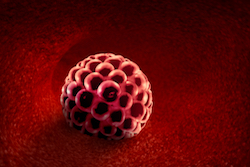Fitting another jigsaw piece into our understanding of early embryo development
As mice are genetically similar to humans, their embryos have long provided useful models to better understand human development. However, while the pre-implantation stages of mouse development have been extensively studied in the lab, this has not been the case for the implantation stages which, occurring in the uterus, have been largely hidden from view. To further shed light on embryonic development, the EU-funded EMBRYONIC ROSETTES project looked at how cell infrastructure in mice works to regulate the collection of messenger RNA molecules – known as the transcriptome – which controls cellular differentiation, by triggering gene expression. The project found that the organisation of the nucleus can differentially regulate the transcriptome, helping establish embryonic (EPI) and extra-embryonic (TE) lineages, and that this process involves the CARM1 enzyme. Embryonic development stages Macromolecules called chromatin are made up of a DNA, RNA and protein mix. They are found in the nucleus of mammalian cells and it is known, from mouse embryo studies, that their spatial arrangement during pre-implantation helps activate the genes which determine how the embryo then develops. These molecular processes range from DNA replication to RNA transcription and processing. After fertilisation, a structure known as the zygote is formed which, after a few cellular divisions, is itself transformed into a blastocyst. The macromolecular chromatin is reprogrammed in the embryo after fertilisation for the establishment of the three so-called lineages of the blastocyst: the pluripotent epiblast (EPI) that gives rise to the future body of the animal, the extra-embryonic primitive cell layers called endoderm (PE) and the trophectoderm (TE), the other extra-embryonic tissue that forms the placenta. Explaining the rationale for EMBRYONIC ROSETTES, project coordinator Dr Anna Hupalowska says, “We know that nuclear re-organisation of chromatin after fertilisation influences the fate and development of the embryo; however, this has never been carefully examined during early mammalian development”. The nuclei of higher eukaryote (organisms whose nuclei are enclosed by membranes), contain multiple sub-nuclear bodies that mediate distinct molecular processes, ranging from DNA replication to RNA transcription and processing. During the project’s pilot experiments, the team observed a marked increase in number and intensity of an enzyme called CARM1, specifically in the 4-cell stage embryo. It was organised into characteristic concentrations identified as paraspeckles, a relatively new class of sub-nuclear body formed by RNA-protein interactions. As Dr Hupalowska recalls, “The number of CARM-containing paraspeckles at the 4-cell stage of embryo development correlates with levels of the methylated histone H3 protein which has previously been shown to directly relate to cell fate specification. This is an indicator of the important role paraspeckles also plays in correct embryo development.” Indeed, the project found that when changing paraspeckle structures by removing core components, embryo development was arrested before reaching the blastocyst stage. Rewriting the textbook? Paraspeckles regulate the expression of certain genes by retaining some RNAs and controlling the export of others. Both functions are related to the activity of the CARM1 enzyme, which has been shown to drive cells towards a pluripotent fate, capable of forming different cell types. The project’s work showed that disruption of paraspeckles also disrupts the sequence of events necessary for this pluripotent blastocyst lineage to unfold. The next step in the research will be to determine if the retention of specific transcripts within the nucleus occurs in the early mouse embryo and whether this can be regulated by CARM1 and paraspeckles. As Dr Hupalowska explains, “By cataloguing transcripts, whose expression and function could be regulated by nuclear architecture, we will be able to characterise the impact of genes on development and cell fate specification. This work is likely to influence methods for manipulating embryonic stem cells to regulate their organisation and differentiation, ultimately offering better healthcare options.”







